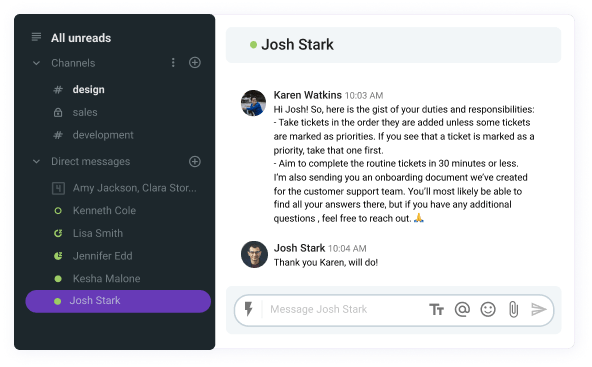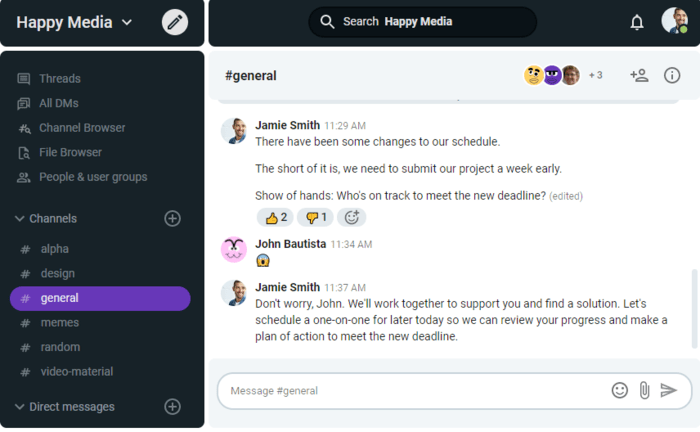Being called a micromanager is the furthest thing from a compliment you can receive in a business setting. When they have good intentions (which isn’t always the case), micromanagers may be commended for their engagement and passion, but even then, their efforts are misguided.
On the other hand, micromanaging tendencies are often born from unhealthy mindsets that lead to downright detrimental and productivity-wasting effects.
In this blog post, we’ll look at some of the reasons why micromanaging occurs, with special attention placed on reasons specific to the remote work environment. We’ll also highlight several signposts that can help you identify whether you have a problem with micromanaging. Finally, we’ll offer 9 tips aimed at helping you to stop micromanaging your remote team.
Table of Contents
What is micromanagement?
Micromanagement is a pattern of management behavior where a manager excessively oversees, controls, and observes the work of their employees. Aside from that, a manager who practices micromanagement has trouble delegating tasks or decisions to their subordinates.
Why does micromanagement occur in remote work?
For the most part, the causes of micromanagement are the same, regardless of whether they manifest in an office environment or a remote work environment.
These causes include:
Lack of managerial training
Sometimes, managers are employees who excelled at their original positions and got a promotion. However, it’s important to understand that the qualities that make a great employee and the qualities that make a great manager aren’t the same. Micromanagement tends to occur when first-time, newly-promoted employees get hold of a managerial position and aren’t sure how they should act. They know it’s up to them to ensure the team operates successfully, so they approach the job the only way they know how — at a micro-level. In these cases, they end up doing the same job they did when they weren’t managers, only on a much larger scale.
Unskilled employees: Sometimes, the blame doesn’t lie entirely with managers. Managers are responsible for their team’s productivity output. When they are surrounded by capable employees, managers can more easily feel unfettered from the need to micromanage everything. But when the hiring process lets through incompetent candidates, managers often feel they are must resort to micromanaging to sustain the desirable productivity output.
Lack of self-confidence: It’s not uncommon for managers to feel threatened by team members who excel at their jobs. In these cases, managers may resort to micromanagement as a form of sabotage or excuse to attribute the overall team success to themselves.
However, the thing that seems to drive most managers towards these undesirable practices in a remote environment is lack of control.
Lack of control: the remote work specific cause of micromanagement
Simply put, in an office environment, managers could always stroll by their subordinates to make sure they were working or check in on their progress. Even if they didn’t exert this level of control frequently, they knew they could; everyone knew they could. But the lack of physical interaction brought about by the large-scale shift to a remote work model has made this harder. Now, managers can’t simply glance around the office and see who’s hard at work and who’s goofing off, which leads to trust issues. In this case, managers who feel threatened or powerless due to this lack of control seek to establish it virtually, which they believe can only be done through micromanagement.
Signs that you are a micromanager
Different practices can be described in different ways.
Whom we describe as blunt you may describe as sincere. The same goes for stingy and thrifty, childish and childlike, meticulous and picky; the list does go on.
So, just because you might describe yourself as detail-oriented or thorough rather than a micromanager, doesn’t mean others perceive you in such a positive light.
Because subjective evaluation can be misleading like this, we suggest looking at this list of signs you may be a micromanager for a more objective analysis.
You may well be a micromanager if:
✅ You feel the need to personally approve every single decision your team members make
✅ You act as a gatekeeper, preventing team members from coming into contact with the people above you or other teams
✅ You consider conversations with employees as opportunities for evaluation
✅ You feel employees are reluctant to share their thoughts and troubles with you
✅ You aren’t focused on the customer
✅ You refuse to delegate work
✅ You have a high employee turnover
✅ You insist employees do the work your way
✅ You don’t share information with your team members
9 steps to help you stop micromanaging your remote team
If some of the above-listed points ring true, then you can forget about using the detail-oriented description to paint yourself in a positive light. Luckily for you, there are 9 simple steps you can take that will help you stop micromanaging your remote team.
1. Remember what your job description entails
Circling back to the reasons why micromanagement occurs in the first place, we’ve mentioned that one of the causes comes down to the simple fact that many managers are better workers than managers. Many have been promoted to this position not due to their managerial skills, but due to their skills as team members. If lacking the proper training or awareness to distinguish this paradox, it’s only natural for managers to zero in on the details that made them great at their job, which inevitably results in micromanaging.
Be mindful of the fact that your job is to look at the bigger picture and enable your team. Have faith in them. As Simon Sinek aptly put it in one of his talks, managers have to understand that they are no longer “responsible for the job,” instead, they’re “responsible for the people who are responsible for the job.”
That’s your job description. If you’ve landed your position as a manager or team leader through hard work and excellence, then chances are you can, indeed, do the job better than any single subordinate working under you. But to dwell on this is to completely miss the idea behind the position you currently hold. Your job is to remain mindful of the big picture and enable all team members to give it their one hundred percent. Let them do their job and you do yours.
2. Explain what needs to be done, not how to do it
“There’s more than one way to skin a cat,” says the old proverb.
Managers likely have their preferred methods of doing things. This is normal. Sharing this path to success is in itself a well-meaning act.
The issue strikes when you begin insisting on your preferred methodology. Such strict, yet in most cases unnecessary rules can only serve to stifle employee creativity and innovation. So long as the desired results are achieved without missing the deadline, it shouldn’t matter whether or not the employees did things your way or not.
It’s better to inform your team members on what they are expected to do and leave the how to them. Let them know that they can turn to you for guidance if they’re having trouble, but don’t puppeteer their actions.

3. Focus on results
One of the ways in which you can rid yourself of the need to assert control at any given moment and embrace the wonders of remote work is by reevaluating your priorities. In-office managers are sometimes just as concerned about subordinates spending their designated working hours with their butts firmly planted in their seats as they are making sure all team members are doing quality work.
There is a stigma surrounding remote employees that characterizes them as lazy bums who sit around in their pajamas all day, drinking beer and bingeing their work (if they do it at all) to leave more time for hobbies and TV. In most cases, the opposite is true. Remote employees are more likely to soldier through their duties even with symptoms of flu.
But regardless of this, it’s important to understand that, short of resorting to inhumane monitoring practices straight out of Orwell’s “1984”, you simply can’t play the police officer who will demand that butt-in-seat time be everyone’s number one priority. Even ignoring the fact that, on average, remote employees clock in more hours, rendering this worry mute, focusing on what you can’t do is in no way productive.
What you should do instead is adopt a work climate that is result-oriented. So long as employees are delivering desired results, on time and consistently, then the whole team has done its job well. Conversely, attempts at remote micromanagement only serve to distract remote employees from their work and set them back; that’s one way to make sure they stay seated for longer, but it’s not in your best interest. To help you make the jump to a result-oriented management style, refer to the following tip.
4. Set deadlines and expectations
Deadlines and expectations exist, whether you’re employing a result-oriented approach or not. The problem, in either case, emerges when these deadlines and expectations aren’t communicated clearly and transparently. If, perhaps as a result of withholding information, you haven’t told your team members when their work is due and instead expect them to do it as soon as possible — which, as a micromanager, you think they ought to be able to if they spent every waking moment exclusively focused on this issue and somehow understood its importance — then you’ve got a problem.
Deadlines can be frustrating, sure, but they can also be motivating and performance-boosting. Knowing how much work needs to be done until a project is complete can make team members more engaged to contribute. Furthermore, when employees are privy to this information, they feel more valued and trusted, instead of feeling like a cog in a machine, expected to do one thing only and not worry or care about the overall mechanism they’re helping to run.
What’s more, deadlines can help you check in on employees’ progress in a manner that doesn’t feel disruptive. They’ll know that a progress check is due (and reasonable) as the deadline looms closer. Negotiate manageable deadlines with the team, as well as how and when they should expect to give progress updates. This way, you won’t lose any valuable info you need as a manager, and you won’t have to micromanage the team to death in order to obtain it.

5. Schedule regular check-ins
Do note that abandoning micromanagement practices does not mean forgoing all oversight and communication with the team. These are still crucial aspects of your job as a team leader. You need to know what’s going on and how everyone is progressing. You just don’t need to concern yourself with every minute detail. And, of course, you don’t want to go about this in a disruptive manner, which is what micromanaging usually leads to.
The way to do this is simple — schedule regular check-ins with your team. This will give you a chance to keep up to date in an organized and non-disruptive manner.
Also, keep in mind that a check-in is not a two-hour video call marathon where you address all issues at once to an audience that likely can’t follow all the seemingly disparate info. These scheduled check-ins should be shorter and more frequent — daily, weekly, twice-a-weekly, it’s up to you. During these meetings, you can ask team members how they are feeling and whether they are progressing smoothly. Additionally, consider this your opportunity to give the team updates on the general goings-on inside the company. This may not be directly related to their position, but employees want to be in the know regarding important company news and decisions. Withholding this information can only serve to motivate the activation of grapevine channels among employees, which can have negative consequences.
During check-ins, employees can, of course, inform you of any issues they’ve encountered, but these check-ins shouldn’t focus on this type of feedback unless something that affects the entire team is mentioned. Speaking of feedback…
6. Offer feedback
Providing feedback is an essential part of a manager’s job. If we understand the manager’s job description as detailed in tip number one, it may well be the most important part of their job. But for many, giving feedback in a remote team is proving difficult. This is further made clear by study results showing that remote employees receive less performance feedback than their in-office colleagues. On top of this, research shows that, when they do receive the feedback they so desperately crave, remote workers are far more likely to receive corrective feedback and twice less likely to receive positive feedback.
Micromanagers may feel like they’re providing useful feedback (albeit in the form of commands and instructions), but this is insufficient to sustain a healthy remote team relationship. This is why remote team leaders should get in the habit of scheduling one-on-one meetings with their subordinates to provide constructive feedback — this includes the positives as well as the negatives. If you’re having trouble with this, remember that it’s always best to start with the positives. If you’re having trouble with this, try highlighting one of their positive work qualities and explain how improving in other areas will make them excel further. For example, “Jake, your ability to predict which features will be a hit with customers is remarkable, but I feel that you have trouble clearly expressing what makes the features so great. How do you think we could work on this issue so that the rest of the team can follow your train of thought?”
7. Hold yourself accountable
If you’re frustrated that your micromanagerial tendencies are hard to ditch, just think of how your team feels. The only thing is, your subordinates likely won’t feel comfortable calling you out on this. For all they know, this is your preferred management style, and they just have to learn to live with it and vent among themselves when they have the chance.
It doesn’t have to be this way if you choose to be transparent with your team. Tell them that you’ve noticed how your obsession with details or intimate relationship with their schedules (or any other productivity-busting micromanagement habit that you’ve fallen into) frustrates you and explain that you don’t wish to continue managing the team in this style. You can even openly invite them to call you out should you revert to this type of behavior.
A lot has been said about keeping remote employees accountable, but don’t think that you, as a team leader, are above this. This will not only increase the level of trust your team holds in you, but it will also make them more understanding of your predicament.
8. Reevaluate the hiring process
When discussing what leads to micromanagement, we mentioned hiring incompetent employees as one of the reasons that invite or even necessitate micromanagement. Therefore, preventing this from happening by reevaluating and tweaking the hiring process is bound to prevent leaders who otherwise aren’t prone to micromanagement from succumbing to it.
The tricky thing here is that micromanagers generally cause a high employee turnover. Regardless of how competent or incompetent employees are, few of them are willing to tough it out in such a working environment if presented with other opportunities.
This results in a chicken versus egg situation, where an unideal hiring process causes management to resort to micromanagerial practices, while at the same time these practices speed up employee turnover, which necessitates expedient hiring.
In any case, while improving the hiring process in a way that only permits the employment of skilled and competent employees isn’t guaranteed to stop everyone from micromanaging their remote teams, it’s still a worthwhile endeavor.
9. Introduce remote employee training
Just because an employee has the requisite skill to do a certain job does not mean they will automatically and naturally acclimate to the challenges of remote work. Regardless of whether your team works remotely due to external circumstances or deliberately, make sure that everyone on the team is familiar with all tools available to them and ways in which they can facilitate workflow.
💡 If you aren’t sure which tools would best fit your remote team, take a look at this list of 30 tools every remote team should consider.
Different teams will require different tools, but always be mindful of bombarding your team members with too many apps. Additionally, you can ask the team whether they have any preferences regarding potential tools listed here. The only tool that remains a strict requirement for all remote teams is a team communication tool.
Building on this, don’t assume that employees are born adept at using these various apps. While the massive inflow of digital natives into the workforce will certainly raise the chances of employees figuring things out on their own, it’s better to leave nothing to chance and instead schedule a separate onboarding meeting to each of the tools your team will be using. Whichever team communication tool you use, remember that proper training is key to effective remote communication.
Ensuring employees receive adequate remote work training will help alleviate the urge to micromanage in several ways. Firstly, knowing that employees are using the right tools and are aware of how to properly use them will bring you peace of mind. More importantly, many team collaboration tools have built-in deadline reminders and automatic or manual progress checkers. To give the simplest example, if a team is using Google Docs, then you as the manager can pop in and check on progress if you’re feeling anxious. You can even gauge progress in a less invasive manner by asking the team to react to messages on Pumble or any other team communication tool in a predetermined way (👍 means yes, 👎 means no, 👀 means you’re just letting everyone know you’ve seen the message, and so on).

Conclusion: Proper understanding of management renders micromanagement superfluous
Management is all about leading your team to success. Leadership is a skill; it can be trained and honed, just like any other. Good leaders are those who understand this and have invested time and effort into mastering this skill. Micromanagement, on the other hand, is incompatible with effective leadership in remote teams. Understanding this is the first step towards stopping this unwanted practice. Once that’s done, everything else can be handled by following the 9 steps outlined above.




